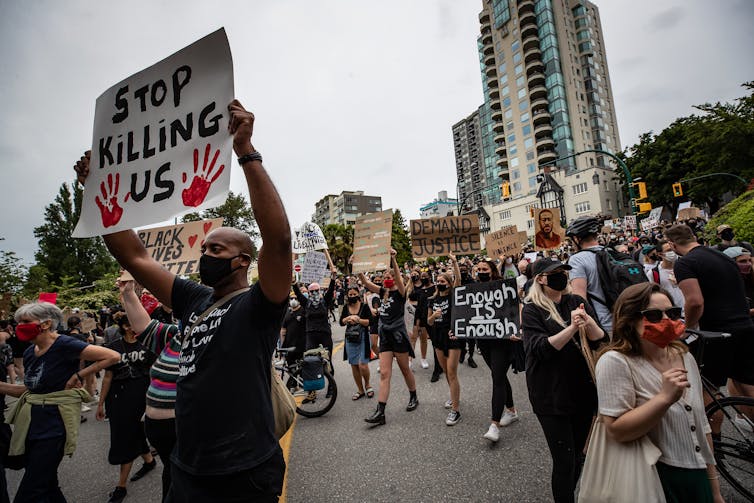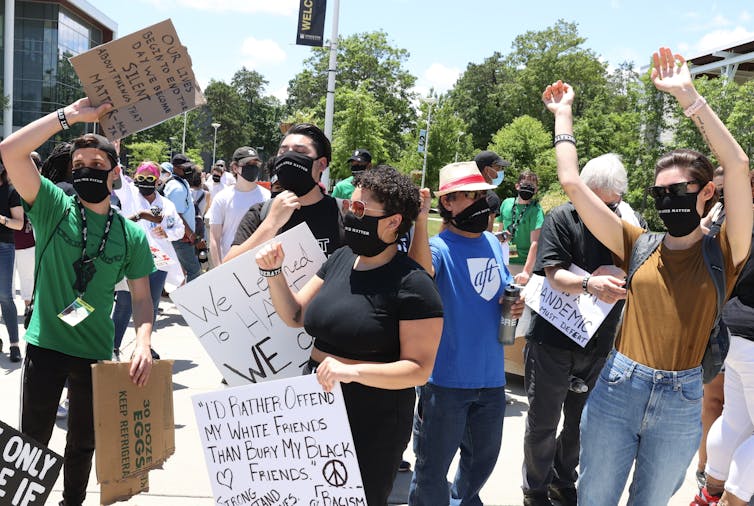On June 19, African Americans will celebrate Juneteenth. This day marks emancipation from chattel slavery and the long and violent struggle for Black people to be recognized as equally human.
Despite Republican efforts to ban the teaching of accurate Black history in schools, Juneteenth became a federal holiday in the United States in 2022, signalling that Black history is American history.
While this is not an official holiday in Canada, it is significant for thinking about the history of race, racial relations and education.
Canada and the United States - once part of the British Empire - share a settler-colonial history. It is in this context that ideas about race were developed and circulated.
Colonialism and race
The project of colonialism required Europeans to categorize and classify the natural world. They sought to do the same thing with humans. European men saw themselves as superior to all other humans, including European women. They applied this ideology to race science.
Carl Linnaeus, who developed the system that replaced local Indigenous names of flora and fauna with Latin names, also described “species” of humans. Europeans were described as “white, sanguine (cheerful), muscular and Africans as "black, phlegmatic (unemotional), lazy.”
Race science placed Africans at the bottom of the hierarchy of human and was used to justify genocide, colonialism, segregation and, of course, enslavement. These ideas about race that developed during the colonial era continue to influence the experiences of Black people in Canada today.
University of Columbia’s Black Studies professor Saidiya Hartman refers to this as the afterlife of slavery, meaning the violence and dehumanization that Black people endured during enslavement continue in present forms of racial violence, high incarceration rates, substandard education and anti-Blackness in health care.
Black enslavement in Canada
Canada’s image of being multicultural and welcoming is maintained by erasing histories of enslaved Africans and denying racism. History about slavery emphasizes Canada’s role in the Underground Railroad as a safe haven for the self-liberated.
However, Canada contributed to and benefited from enslavement in the British colonies.
Slavery was practised in Canada for more than 200 years, longer than Canada has been a nation. Unearthed narratives pertaining to the experiences of Black people in Canada reveal that they were treated as inhumanely as their counterparts in the United States.
The work of Nigerian-raised artist Oluseye Ogunlesi has documented how at least 60 ships that were used to carry stolen Africans to the colonies were built in Canada.
Race and education in Canada
Canada has a history of racially segregated schools and denying Black students admission to medical and nursing schools.
In contemporary primary and secondary schools, Black students are more likely to be tracked into lower level classes, feel discriminated against by teachers and are at risk of not completing high school and entering post-secondary education.
Recent Statistics Canada data reveals that Black Canadians who have been in Canada three or more generations are less likely to have achieved a bachelor’s degree or higher than Black people who have recently arrived in the country. This points to the racism that Black students in Canada encounter in their education.
Read more: Black youth yearn for Black teachers to disrupt the daily silencing of their experiences
Black students describe experiences of feeling isolated, having their experiences of racism dismissed by teachers, hearing ignorant comments from teachers and peers and negative assumptions about their intellectual abilities.
In research my team conducted about the experiences of racialized students in in post-secondary science, technology, engineering and mathematics (STEM) programs, Black students describe being excluded from peer groups, followed by security and having their abilities questioned by their peers.

Equity, diversity and inclusion in universities
The 2020 murder of George Floyd catalyzed racial reckoning across Canadian institutions.
Black-led organizations such as the Canadian Black Scientists Network emerged to elevate, make visible, celebrate and connect Black Canadians in science.
Universities ramped up equity, diversity and inclusion (EDI) efforts and solidified statements aimed at addressing racism and bias in post-secondary education. Universities across the nation signed the Scarborough Charter as a commitment to address anti-Black racism and foster Black flourishing in post-secondary education.
A study of Canadian University EDI statements found that although institutions appear to be prioritizing EDI, the language defining equity, diversity and inclusion is broad and vague, suggesting a “slogan-like” use of the term, potentially overlooking the detailed complexities within each term.
They also noted that the people who were making policy decisions about EDI were mostly those who have benefited from systemic racism.
At the University of Calgary, political scientist Malinda Smith is the vice provost and associate vice-president of research in the Office Equity, Diversity and Inclusion.
Her research has documented the importance of Black and other historically marginalized people being actively involved in policy and decision-making designed to address inequity. Her work notes that you cannot make decisions about Black people without Black people at the table.

Juneteenth and racial equity
Juneteenth could provide the context for reflection on how we can expose, address and dismantle the systemic ideologies about race that maintain inequity in education.
Leaders in education need to do deep, reflective work to recognize and address their own biases, and the ways that white supremacy shows up in educational policies and practices. They need to articulate strategies and action plans for institutional transformation. They also need to ensure that sufficient resources are allocated for equity-focused projects.
Universities must not fall into the trap of performative EDI. This is avoided by identifying equity challenges at institutions and articulating actions, strategies and milestones for change.
Paths to senior leadership
Educational institutions should provide initiatives to recruit and retain Black educators and universities should ensure that there are pathways to senior leadership for Black faculty.
Faculty who are concerned with social justice can draw inspiration about subversion and using the tools of the university to dismantle the anti-Black, racist, colonial ideologies.
August 1 is Canada’s Emancipation Day. Following Juneteenth, this could provide the context for reflection on Black history as Canadian history and ways to centre and leverage Black joy in learning spaces.
Jennifer D. Adams receives funding from SSHRC.
This article was originally published on The Conversation. Read the original article.







